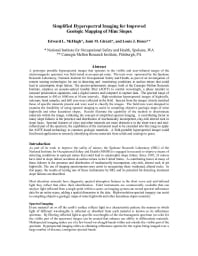Mining Publication: Simplified Hyperspectral Imaging for Improved Geologic Mapping of Mine Slopes
Original creation date: May 2003
Authors: EL McHugh, JM Girard, LJ Denes
NIOSHTIC2 Number: 20036302
Intelligence in a Materials World: Selected Papers from IPMM-2001, the Third International Conference on Intelligent Processing and Manufacturing of Materials. Meech JA, Viega MM, Kawazoe Y, LeClair SR, eds., Boca Raton, FL: CRC Press; 2002 May; :143-152
A prototype portable hyperspectral imaging system that operates in the visible and near-infrared ranges of the electromagnetic spectrum was field-tested at an open-pit mine. The tests were sponsored by the Spokane Research Laboratory, National Institute for Occupational Safety and Health, as part of an investigation into remote sensing technologies for use in detecting and monitoring conditions in surface mines that could lead to catastrophic slope failure. The spectro-polarimetric imager, built at the Carnegie Mellon Research Institute, employs an acousto-optical tunable filter (AOTF) to control wavelength, a phase retarder to measure polarization signatures, and a digital camera and computer to capture data. The spectral range of the instrument is 450 to 1000 nm at 10-nm intervals. High-resolution hyperspectral images of highwalls, outcrops, hand samples and drill core were collected in the field. Spectra from the images closely matched those of specific minerals present and were used to classify the images. The field tests were designed to examine the feasibility of using spectral imaging to assist in compiling objective geologic maps of mine highwalls and other hazardous slopes. Results illustrate the capability of the method to discriminate materials within the image, validating the concept of simplified spectral imaging. A contributing factor in many slope failures is the presence and distribution of mechanically incompetent, clay-rich altered rock in slope faces. Spectral features of clays and other minerals are more distinctive in the short wave and mid-infrared part of the spectrum; the capabilities of the instrument need to be extended into this range to apply the AOTF-based technology to common geologic materials. A field-portable hyperspectral imager could find broad application in remotely identifying diverse materials from solids and coatings as well as gases.

NIOSHTIC2 Number: 20036302
Intelligence in a Materials World: Selected Papers from IPMM-2001, the Third International Conference on Intelligent Processing and Manufacturing of Materials. Meech JA, Viega MM, Kawazoe Y, LeClair SR, eds., Boca Raton, FL: CRC Press; 2002 May; :143-152
- Advances in Remote Sensing Techniques for Monitoring Rock Falls and Slope Failures
- Analysis of Bench Crest Performance at the Yellowstone Mine: A Case Study
- Applications of Ground-Based Radar to Mine Slope Monitoring
- Applications of the Point Estimation Method for Stochastic Rock Slope Engineering
- Assessing and Monitoring Open Pit Mine Highwalls
- Current Research on Slope Movement in Mines: Use of Hyperspectral Imagery
- A Feasibility Study for the Detection of Weak Electromagnetic Signal/ Bursts With Hard-Limited Arrays
- Material Properties Affecting the Stability of a 50-Year-Old Rock Dump in an Active Mine
- A Portable Spectro-Polarimetric Imager: Potential Mine Safety and Geologic Applications
- Slope Stability
- Technology News 506 - The Sky is Falling!: NIOSH Releases Safety Video for Surface Mining Operations